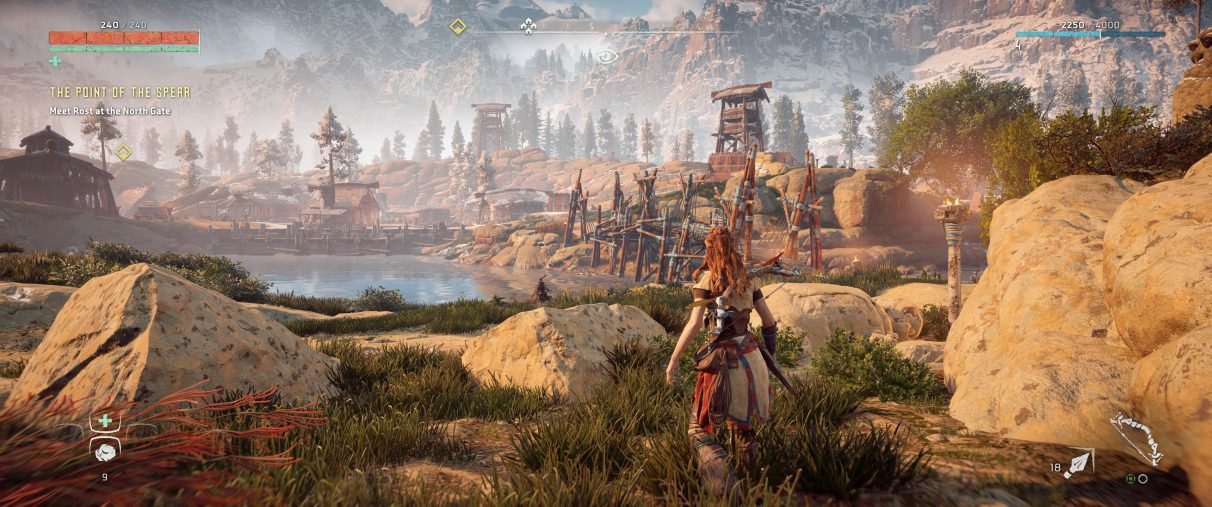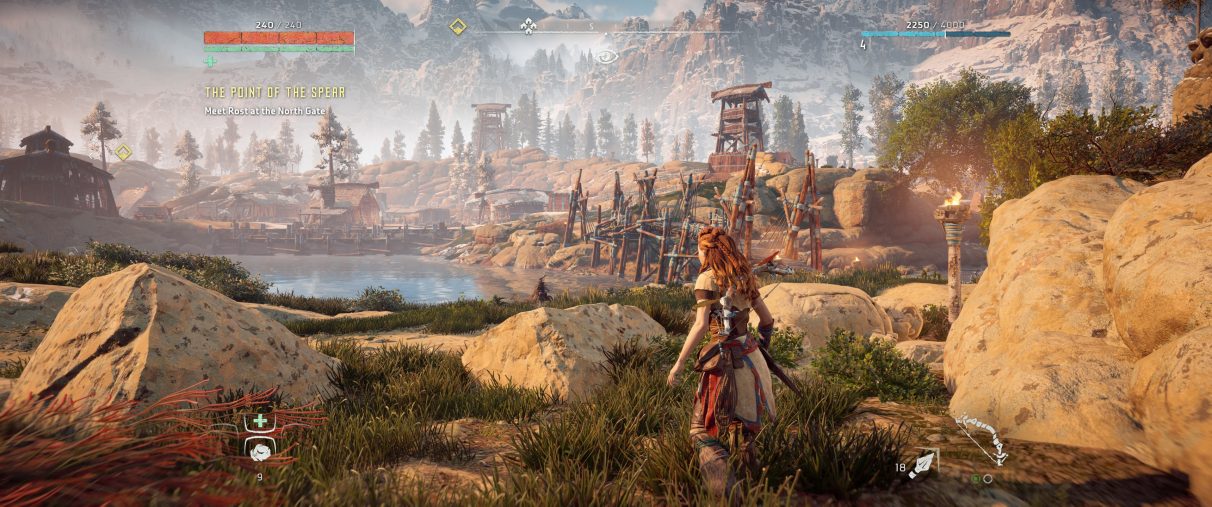Now, while it’s since become apparent that not all members of the press have had quite as smooth an experience as I have with Horizon Zero Dawn’s PC port, I can only report on my own experience of the game, which so far as been pretty plain-sailing. To test Horizon Zero Dawn’s ultrawide support, I used Asus’ ROG Swift PG35VQ, the same monitor that I’ve been using to play Death Stranding. This is a curved 35in, 3440x1440 display with a 200Hz refresh rate and Nvidia G-Sync Ultimate support, and I’ll be writing up a separate review of this monitor very soon. In the meantime, though, it effectively has everything I need to get the most out of Horizon Zero Dawn on PC, as it means I can make use of all its new features in one fell swoop, from its uncapped frame rates and HDR support to its lovely ultrawide aspect ratio. The good news is that Horizon Zero Dawn does, in fact, support the same ultrawide resolutions as your typical ultrawide gaming monitor - that is, 3440x1440 or 2560x1080. That might sound like the most obvious thing in the world, but as you may recall from my look at Death Stranding’s ultrawide support, Kojima Productions took a rather more cinematic approach to the game’s 21:9 aspect ratio support, opting instead for a ’true’ resolution of 3360x1440 / 2520x1080. This meant there were still tiny black bars running down the side of your screen in Death Stranding, but thankfully this isn’t the case in Horizon. Here, there’s nothing getting in the way of the game’s 21:9 goodness, and cor, what a sight it is, too. Just take a look at these GIFs to see what I mean. The bad news is that Guerrilla Games have maintained their original 16:9 aspect ratio for all of Horizon Zero Dawn’s in-game cutscenes. That means everything from big story sequences, like Aloy’s big growing up montage at the beginning of the game, to tiny NPC interactions such as engaging quest givers in conversation. This is a touch disappointing, especially after Kojima’s team went to the trouble of re-doing all of Death Stranding’s cutscenes to work with its newly supported aspect ratio. However, rather than shrink the action down with a pair of black bars when this happens, a la Red Dead Redemption 2, Horizon Zero Dawn opts for an altogether different approach by ’extending’ the scene with darkened, blurred out recreations of the scene in question, duplicating the edges of the original 16:9 footage so it still fills the width of the monitor. I’m of two minds about this. On the one hand, I like that I don’t have to deal with horrible black bars every five minutes, but on the other I also find it quite distracting. It’s fine when the cutscene is relatively simple in composition, as this allows the blurred-out sections of the screen to feel like a natural extension of what’s happening in front of me, as you can see below: It gets more problematic when the cutscene grows in complexity, though. Take a look at little Aloy discovering her scanner doodad for the first time. The scene works when she’s just scrabbling around in the darkened cave, but the moment she activates her new trinket, the augmented reality mesh that surrounds her is abruptly cut off when it hits the blurred bits. There’s a faint trace of it coming through in the blurry excess, but the way it’s been duplicated means the lines are also at the wrong angle, adding to the sense that there’s just something slightly off about it - an issue I’d imagine only gets worse when you start playing Horizon on super ultrawide screens such as the 32:9 Samsung CRG9. Guerrilla Games have said that Horizon Zero Dawn does support 32:9 aspect ratios in addition to 21:9 displays, but I would think this extended pillar-box effect would be even more jarring when there’s so much more of it to look at. It’s not ideal, but I’m also aware that this slightly marmite approach will probably be far less distracting for some than others. The more time I spend playing the game, the more grateful I am that it doesn’t just keep cutting to black bars all the time. Sure, it would have been great if all the cutscenes had been redone in 21:9 like Death Stranding (or at the very least the small NPC conversations), but I’ll take a vague, blurry suggestion of something over a literal black hole any day of the week. Where Horizon Zero Dawn really shines in ultrawide is its extensive HUD and field of view controls. You’ll find the former in the General tab of the Settings menu, while the latter is tucked away in Display, but golly, these really do pack a serious punch. I’ll start with the HUD, which is set to push everything to the edge of the screen by default, allowing you to get the full whack of the game’s gorgeous vistas. It’s still quite a busy HUD in the grand scheme of things, especially compared to the super minimal Death Stranding, but it’s not like you’re having to constantly crane your head to check for context sensitive controls as you do in Red Dead Redemption 2, and I found it pretty manageable like this. You can, however, choose to switch off HUD To The Edges, which sticks all the bars back to their original 16:9 position, as shown above. This does make it easier to see at a glance, but it does obscure some of the game’s lovely backdrops. Fortunately, you can also dictate how much of the HUD you see onscreen at any given time. As well as switching off the quest and waypoint pathfinder, you can also change the scale of the HUD, making elements bigger by up to 1.2x their original size (or smaller by up to 0.7x), and set it to Dynamic or Custom. The former will keep everything to a minimum unless you’re in combat, and it also gives you the option of only showing the HUD when you hold down H. Custom, on the other hand, lets you adjust every tiny detail, from enemy awareness icons, health bars and damage numbers to bigger stuff like your compass, reticule and stealth indicator. You’ve got buckets of choice, in other words, a lot of which goes a long way to make up for the game’s slightly underwhelming cutscenes. Combine those HUD settings with Horizon Zero Dawn’s field of view bar, however, and you’re off to the ultrawide races. It’s set to 70 degrees by default, which has the camera hug Aloy’s back much like it did in the PS4 original. However, if you set it to the top 100 degrees setting, the camera yawns back to show a much larger proportion of the surrounding environment. There’s a bit of fish-eye going on at this kind of FOV extremity, but man alive does it make the game’s expansive vistas look infinitely prettier and more inviting. You get a much greater sense of what’s going on around you when the camera’s pulled back like this, and it really lends itself to creating a more immersive ultrawide experience. 70 degrees 80 degrees 90 degrees 100 degrees Of course, you do need a reasonable graphics card to make the most of Horizon Zero Dawn in ultrawide, especially if you want to make the most of its extra FOV settings. I’ll be doing a more in-depth graphics performance piece tomorrow to show you what kind of frame rates you can expect on different quality settings with as many different graphics cards I can get my hands on, but the FOV slider does make a difference. For example, I found my RTX 2070 Super averaged around 55fps on Ultimate Quality at 3440x1440 with the FOV slider at its default 70 degrees, but this dropped to around 50fps when I set the FOV to 100 degrees. Consequently, if I wanted to maintain that higher frame rate at 100 degrees FOV, I felt like I had to drop the quality preset down to its PS4-oriented ‘Original’ settings to get a frame rate that was consistently above 60fps. Personally, I was quite happy playing Horizon Zero Dawn at 50-odd fps with my RTX 2070 Super, as it still felt perfectly smooth and playable to me in the moment. Besides, anything above the locked 30fps you get on console is a bonus in my book, so you should still get plenty of enjoyment out of Horizon Zero Dawn even if your graphics card struggles to reach a steady 60fps. That said, if you fall into the camp where it’s 60fps on Max or bust, then you’ll probably want to ensure you’ve got an RTX 2080 Super in your PC, especially if you’re eyeing up that 100 degrees FOV slider. Overall, though, Horizon Zero Dawn does look a treat in ultrawide, even if its cutscenes aren’t quite to the same standard as old Death Stranding. There are plenty of additional settings on hand to really take advantage of that extra screen width, and the game’s insanely pretty and detail-packed environments have never looked more jaw-droppingly gorgeous. Plus, its photo mode supports the full 21:9 aspect ratio as well, which is more than can be said for Red Dead Redemption 2. If you’ve got an ultrawide monitor at home, you should definitely give it a go.







